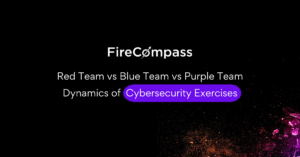In this article, we will find out if you as an organization are ready for an assessment. While most organizations today have gone through some of the other forms of assessment, it is important to know if you as an organization are at the stage of exploring red teaming.
Before we move into that, we will see the different forms of assessment, we have – Vulnerability Testing, Penetration Testing, Application Testing, Red Teaming, and Purple Teaming.
While most organizations would have done the more traditional forms of assessment like vulnerability testing and pentesting, red teaming is slightly more time consuming and requires a lot of manual effort. So we see lesser organizations going for red teaming in general. However, with changing times, we see experts giving more importance to red teaming than other traditional methods of testing. The reason being the nature of threats have evolved, and if you need to protect yourself, you need to start thinking like a hacker.
So to assess yourself you first need to know if you are a target or are optimistic. Let’s see what I mean by target and optimistic
Target – If your organization has a good brand name & if you have the attention of the nation, Bad actors will go after you.
Optimistic -If you think your organization does not catch attention and so you are not paying attention, the bad actors will find you.
Let’s say you think you are not important, but the actors can possibly use you for a higher-end target. For example, your client or your partner could be a bigger target than you. But you are the stepping stone to reach them, making you just as valuable.
So in both cases, you are at a disadvantage.
Finding Your Organization Maturity

There are 3 levels of maturity :
- The Foundation layer – This is the level where you have your vulnerabilities and your underlying assets covered. This is the basic level that one needs to cover before going to the next level.
- The Focus level – This is where you enter into penetration testing and get into a defense mechanism
- The Resilience Level – This is where you as an organization can get into a full-blown attack simulation. You form a blue team and then have as many red team exercises as possible.
It is advisable to gradually increase your organization’s maturity levels. Start with Vulnerability testing and graduate to a full-blown attack simulation.
Planning Your Red Teaming

- Assess Maturity Level – Based on the stage your organization is in, assess your maturity level.
- Forming Blue Team – If you start a red teaming exercise, the primary work that needs to happen is to form the blue team. So that red and blue can work in collaboration.
- Organization buy-in – This is typically from the senior management, an assurance that the organization is resilient to overcome whatever comes through. The exercise should not be known to the rest of the organizations apart from some party at stake like HR or legal.
- Approach – The approach of the red teaming needs to be decided. How this whole operation will form, doing research, and finding out the current security posture will help understand what needs to be breached.
- Objective – As Red teaming is based on objectives. The objectives of the operation need to be clear. So that the rest of the activities are aligned.
- Red Teaming Scope – This is the scope of attack that is agreed upon.
- Timeline Duration – What will be the timeline of this operation and by when it needs to be completed. Typically one Red Team exercise could take between a few weeks to a month.
Continuous Automated Red Teaming
While red teaming is an exercise that most organizations need to do once they reach a certain maturity level. CART is a platform that can be availed by organizations that are at the foundation layer. The problem with manual red teaming is that it is expensive and time-consuming. And in the true sense, hackers are attacking organizations every day, and with the emergence of new technologies, sophisticated techniques, and changing attack climate, no organization is truly safe.
While a traditional red teaming exercise is a very long tedious process, it is also done once or twice a year. This means for the rest of the year your defenses are unguarded.
This is where Continuous Automated Red Teaming (CART) comes into the picture. This automated Red Teaming Platform continuously monitors the attack surface and launches attacks to find the gray area.
This platform is an AI that mimics hackers and finds the gaps in security. The advantage of the automated platform over traditional red teaming is that it does it every day and is not a tedious time-consuming exercise.
Also while you might wait for your organization to reach the correct maturity to do a red teaming exercise, CART platforms can be used by an organization that is at the foundation level.




